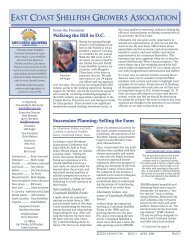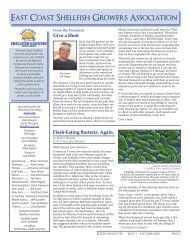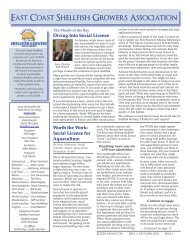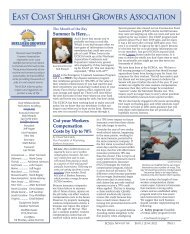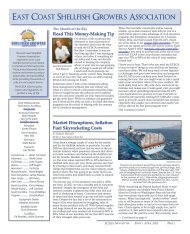ECSGA newsletter December 2022
Articles include: Why the ISSC conference is vital to your business; More on bird interactions with floating shellfish gear; What does the market for shellfish look like in the EU? Stay out of trouble with the IRS by following these tips; Mass oyster mortalities in North Carolina still a mystery; Some new reseach on microplastics in oysters and mussels; Oyster larvae respond to underwater sound! Hurricane Fiona causes millions in losses in Prince Edward Island, Canada; A full preview of all the upcoming shellfish aquaculture conferences this winter; Why do special interest groups have more clout than science? and NOAA's 5-year plan for aquaculture development.
Articles include: Why the ISSC conference is vital to your business;
More on bird interactions with floating shellfish gear;
What does the market for shellfish look like in the EU?
Stay out of trouble with the IRS by following these tips;
Mass oyster mortalities in North Carolina still a mystery;
Some new reseach on microplastics in oysters and mussels;
Oyster larvae respond to underwater sound!
Hurricane Fiona causes millions in losses in Prince Edward Island, Canada;
A full preview of all the upcoming shellfish aquaculture conferences this winter;
Why do special interest groups have more clout than science? and
NOAA's 5-year plan for aquaculture development.
You also want an ePaper? Increase the reach of your titles
YUMPU automatically turns print PDFs into web optimized ePapers that Google loves.
European Market<br />
Opportunities<br />
by Robert Rheault,<br />
<strong>ECSGA</strong> Executive Director<br />
In September, Food Export<br />
USA–Northeast led its first shellfish<br />
trade mission to the Netherlands<br />
and France to introduce<br />
buyers to some of our products<br />
and to weigh interest and gauge<br />
reactions. This came in the wake<br />
of the long-awaited reopening<br />
of shellfish trade with the EU<br />
back in February <strong>2022</strong>. This first<br />
stage of the resumption of trade<br />
allows shellfish sales only from<br />
Massachusetts and Washington<br />
State, and though we believe<br />
other states will be added to the<br />
list of eligible shippers, we don’t<br />
<strong>ECSGA</strong> Newsletter<br />
yet have a commitment from the<br />
FDA or their EU counterparts as<br />
to when that might happen.<br />
Food Export–Northeast interviewed<br />
European seafood<br />
market representative Felipe<br />
Macías of FM Consulting to<br />
find out about the opportunities<br />
in France. Macías said that<br />
France is the biggest producer<br />
and consumer of oysters in the<br />
EU, with a majority of French<br />
people reporting that they eat<br />
oysters regularly or occasionally.<br />
He noted that the French<br />
are discriminating connoisseurs<br />
of the many varieties of oysters<br />
available from other countries<br />
and should be receptive to our<br />
products.<br />
For nearly a decade the <strong>ECSGA</strong><br />
and the Pacific Coast Shellfish<br />
Growers Association pushed<br />
Page 2 Issue 4 <strong>December</strong> <strong>2022</strong><br />
OSMANY TAVARES/ FOOD EXPORT USA –NORTHEAST<br />
At the U.S. trade mission with France and the Netherlands, featured speaker<br />
Chris Schillaci presented an overview of Northeast U.S. oyster farming<br />
history, outlined the differences between the oyster species virginica and<br />
gigas, and explained U.S. shellfish food safety protocols. He is NOAA’s<br />
Aquaculture Coordinator in the Greater Atlantic Region, based in Gloucester,<br />
Massachusetts, and Narragansett, Rhode Island.<br />
hard for the reopening of trade<br />
with the EU, so we were quite<br />
excited when the deal was<br />
finally struck, but so far we’re<br />
hearing that international trade<br />
has been pretty modest. We<br />
know that our oysters have great<br />
flavor, long shelf life and attractive<br />
price points, so we expect it<br />
is just a matter of getting European<br />
customers to try them and<br />
we should have ready markets.<br />
Talking to dealers in Massachusetts,<br />
there are a few barriers<br />
to overcome before they make<br />
large investments in setting up<br />
trans-Atlantic trade. First of all,<br />
markets in the U.S. are quite<br />
robust and there is not a large<br />
surplus of product just hanging<br />
around. In addition, European<br />
markets are well established,<br />
and it might be a challenge to<br />
get Europeans to try something<br />
new.<br />
EU regulations require that<br />
oysters be boxed and packed cup<br />
down to retain the liquor (probably<br />
because they are used to<br />
dealing with the Japanese oyster,<br />
C. gigas, which has a tendency<br />
to gape and dry out). Europeans<br />
are also accustomed to smaller<br />
packaging—25 and 50 count,<br />
instead of 100 count—and they<br />
prefer a 4" to 5" oyster with a<br />
full meat, as opposed to the<br />
petite oysters that have grown in<br />
popularity in the U.S. market.<br />
The other consideration is that<br />
the French market is strongly<br />
seasonal, with about half of all<br />
oyster sales happening around<br />
the Christmas and New Year<br />
holiday period. I think this is<br />
actually a potential boon for the<br />
growers on Cape Cod because<br />
they usually encounter a fall glut<br />
and suffer a price drop when the<br />
wild harvest opens up and growers<br />
become anxious to unload<br />
product before the ice comes in.<br />
I remain optimistic that this<br />
market will expand and mature.<br />
I have always been of the mind<br />
that more markets are always<br />
better and will help keep prices<br />
strong as our production continues<br />
to grow. I hope we hear soon<br />
that more states will be added to<br />
the list of approved shippers; we<br />
will keep up the pressure on the<br />
FDA to ensure that it happens.<br />
OSMANY TAVARES/<br />
FOOD EXPORT USA –NORTHEAST<br />
Local chefs, seafood buyers,<br />
wholesalers and importers,<br />
fishmongers, shellfish organizations,<br />
journalists and USDA Foreign<br />
Agricultural Service reps tasted<br />
oysters and talked about local<br />
products at the trade receptions.<br />
Food Export USA–Northeast is<br />
a non-profit organization that<br />
works with 10 Northeastern<br />
states to facilitate trade between<br />
suppliers and worldwide importers<br />
to promote the export of<br />
food, agricultural and seafood<br />
products. For more info visit<br />
www.foodexport.org/our-programs/seafood-program




